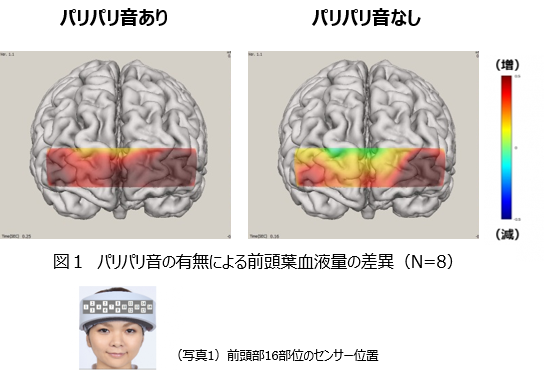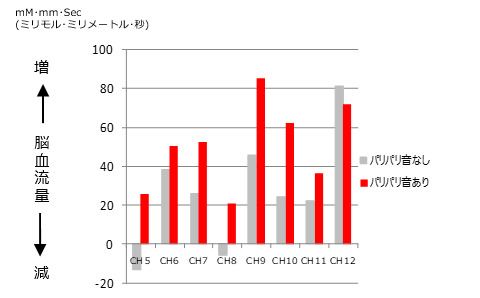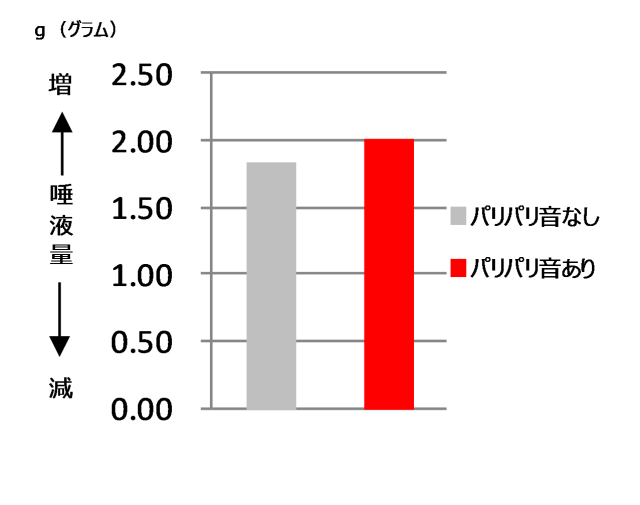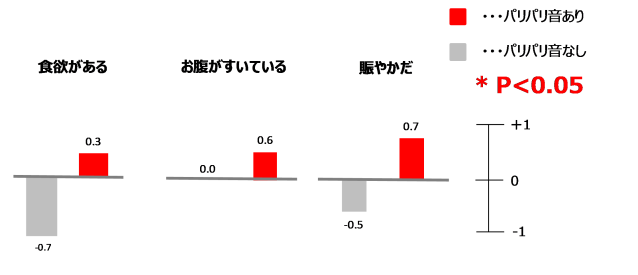
Recent research study investigates the role that not only taste and smell play in increasing your appetite, but sound as well.
On April 10, KFC Japan stores nationwide began selling their new line of Paripari Chicken. “Paripari” is Japanese onomatopoeia used to denote the sound of eating something that’s particularly crunchy and crispy, though it can also refer to a state of liveliness. The Paripari Chicken recipe is described as simple with a light seasoning of salt and pepper in order to maximize its umami flavor and crunchy texture.
The release of this new menu item coincided with the release of an academic study that was conducted to shed light on the effects of sound while eating. Spearheaded by Emeritus Professor Yoshihiko Koga of Kyorin University in Mitaka, Tokyo, the study concluded with two major findings:
- The presence of the paripari sounds while eating strikingly increased participants’ blood flow in the frontal lobe of the brain and also increased saliva.
- The presence of the paripari sounds while eating increased participants’ self-awareness regarding their feelings of hunger, appetite, and positivity.
First, eight healthy individuals were asked to eat chicken for three minutes while listening to paripari sounds and then without listening to them. Their brains’ frontal lobe blood flow was measured using a Spectratech OEG-16ME with 16 measurement sensors attached. Second, participants watched KFC commercials for five minutes both featuring paripari sounds and then not featuring them. Their saliva levels were measured and they also completed a visual analog scale survey of a series of data points related to their self-awareness of their present emotions. Participants were not allowed to eat for two hours prior to the experiment.
Results of Part I
The following diagram illustrates the difference in participants’ blood flow in the frontal lobe of their brains:
▼ Left: while listening to the paripari sounds, Right: while not listening to the paripari sounds
Similarly, here’s a comparison of quantity of blood flow in the frontal lobe both while listening to the paripari sounds (red bar) and while not listening to them (grey bar):
▼ Vertical axis: blood flow in the frontal lobe, Horizontal axis: eight sections of the frontal lobe
As can be seen, there was a demonstrable increase in participants’ brain blood circulation, particularly in section CH9 of the frontal lobe, while they were listening to the paripari sounds.
Results of Part II
Participants watched the following KFC commercials for five minutes, both while listening to the paripari sounds and while not listening to them (note: you should only watch these clips during a time when KFC stores are operating, because you may just find yourself with an overwhelming desire for fried chicken after viewing them!).
▼ KFC’s Paripari Chicken (sushi edit)
▼ KFC’s Paripari Chicken (bread edit)
This graph illustrates the difference in the amount of saliva (in grams) generated when participants were listening to the paripari sounds (red bar) versus when they were not (grey bar):
For the visual analog scale survey, participants responded to a series of 14 data points regarding their current emotions as well as eight data points regarding taste and appetite. Three of the former points are illustrated below (red bar = while listening to paripari sounds, grey bar = while not listening to paripari sounds):
▼ First column: “I am hungry.” Second column: “My stomach is empty.” Third column: “I feel energetic.”
These results also indicated an increase in saliva, appetite, and overall feelings of positive energy when participants were subjected to the sounds.
If you’d like to informally attempt to replicate these experiment results, swing by your local KFC Japan to stock up on the new Paripari Chicken! We’ll leave you to determine the best way to measure your saliva levels…
Source: PR Times
Featured image: PR Times
● Want to hear about SoraNews24’s latest articles as soon as they’re published? Follow us on Facebook and Twitter!





 We try five menu recommendations from a clerk at CoCo Ichibanya and almost fall in love
We try five menu recommendations from a clerk at CoCo Ichibanya and almost fall in love KFC Japan to open new specialty take-out store in Sendai with wholesome deli food!
KFC Japan to open new specialty take-out store in Sendai with wholesome deli food! Kentucky Fried Chicken installs fried chicken pick-up lockers in Tokyo, two other cities【Video】
Kentucky Fried Chicken installs fried chicken pick-up lockers in Tokyo, two other cities【Video】 KFC releases first-ever spicy miso chicken in Japan
KFC releases first-ever spicy miso chicken in Japan KFC Japan earned 6 billion yen over Christmas weekend, proving that Japan loves Christmas chicken
KFC Japan earned 6 billion yen over Christmas weekend, proving that Japan loves Christmas chicken Japan’s new difficult-to-drink-from beer glass protects your liver, but it’s a brutal experience
Japan’s new difficult-to-drink-from beer glass protects your liver, but it’s a brutal experience New Pokémon ice cream, dessert drinks, and cool merch coming to Baskin-Robbins Japan【Pics】
New Pokémon ice cream, dessert drinks, and cool merch coming to Baskin-Robbins Japan【Pics】 New samurai glasses are Japan’s latest weird must-have souvenir
New samurai glasses are Japan’s latest weird must-have souvenir Come play hide-and-seek on a deserted Japanese island this August and November
Come play hide-and-seek on a deserted Japanese island this August and November Nintendo history you can feel – Super NES, N64, and GameCube controllers become capsule toys
Nintendo history you can feel – Super NES, N64, and GameCube controllers become capsule toys Demon Slayer: Kimetsu no Yaiba gets new roller coaster attractions and food at Universal Studios Japan
Demon Slayer: Kimetsu no Yaiba gets new roller coaster attractions and food at Universal Studios Japan Doraemon found buried at sea as scene from 1993 anime becomes real life【Photos】
Doraemon found buried at sea as scene from 1993 anime becomes real life【Photos】 Infographic shows how working culture differs across the globe
Infographic shows how working culture differs across the globe Hello, cosmetics! Clinique teams up with Hello Kitty this summer for first-time collaboration
Hello, cosmetics! Clinique teams up with Hello Kitty this summer for first-time collaboration Japan’s new canned chu-hai with fresh lemon slice: disappointing gimmick or drink revelation?
Japan’s new canned chu-hai with fresh lemon slice: disappointing gimmick or drink revelation? “The most Delicious Cup Noodle in history” – Japan’s French Cup Noodle wins our heart【Taste test】
“The most Delicious Cup Noodle in history” – Japan’s French Cup Noodle wins our heart【Taste test】 Starbucks releases a cute Frappuccino and Unicorn Cake…but not in Japan
Starbucks releases a cute Frappuccino and Unicorn Cake…but not in Japan Kyoto Tower mascot termination reveals dark side behind cute Japanese characters
Kyoto Tower mascot termination reveals dark side behind cute Japanese characters McDonald’s Japan’s Soft Twist Tower: A phantom ice cream only sold at select branches
McDonald’s Japan’s Soft Twist Tower: A phantom ice cream only sold at select branches Yabai Ramen: What makes this Japanese ramen so dangerous?
Yabai Ramen: What makes this Japanese ramen so dangerous? Finally! Nintendo Japan expands Switch 8-bit controller sales to everybody, Online member or not
Finally! Nintendo Japan expands Switch 8-bit controller sales to everybody, Online member or not Japanese government wants to build luxury resorts in all national parks for foreign tourists
Japanese government wants to build luxury resorts in all national parks for foreign tourists To combat declining birth rate, Japan to begin offering “Breeding Visas” to foreigners
To combat declining birth rate, Japan to begin offering “Breeding Visas” to foreigners 10 things you should buy at 7-Eleven in Japan
10 things you should buy at 7-Eleven in Japan Studio Ghibli releases anime heroine cosplay dresses that are super comfy to wear
Studio Ghibli releases anime heroine cosplay dresses that are super comfy to wear Woman charged for driving suitcase without a license in Osaka
Woman charged for driving suitcase without a license in Osaka Studio Ghibli unveils My Neighbour Totoro miniature house model
Studio Ghibli unveils My Neighbour Totoro miniature house model Kyoto experiencing problems with foreign tourists not paying for bus fares, but not on purpose
Kyoto experiencing problems with foreign tourists not paying for bus fares, but not on purpose Fighting mild hunger with a Japanese soda that turns into jelly in the stomach【Taste test】
Fighting mild hunger with a Japanese soda that turns into jelly in the stomach【Taste test】 Studio Ghibli’s Howl’s Moving Castle tapestry unveiled in Japan for first time
Studio Ghibli’s Howl’s Moving Castle tapestry unveiled in Japan for first time McDonald’s new Happy Meals offer up cute and practical Sanrio lifestyle goods
McDonald’s new Happy Meals offer up cute and practical Sanrio lifestyle goods Sales of Japan’s most convenient train ticket/shopping payment cards suspended indefinitely
Sales of Japan’s most convenient train ticket/shopping payment cards suspended indefinitely Sold-out Studio Ghibli desktop humidifiers are back so Totoro can help you through the dry season
Sold-out Studio Ghibli desktop humidifiers are back so Totoro can help you through the dry season Japanese government to make first change to romanization spelling rules since the 1950s
Japanese government to make first change to romanization spelling rules since the 1950s Foreigner’s request for help in Tokyo makes us sad for the state of society
Foreigner’s request for help in Tokyo makes us sad for the state of society Ghibli founders Toshio Suzuki and Hayao Miyazaki contribute to Japanese whisky Totoro label design
Ghibli founders Toshio Suzuki and Hayao Miyazaki contribute to Japanese whisky Totoro label design Tokyo’s most famous Starbucks is closed
Tokyo’s most famous Starbucks is closed Princesses, fruits, and blacksmiths: Study reveals the 30 most unusual family names in Japan
Princesses, fruits, and blacksmiths: Study reveals the 30 most unusual family names in Japan KFC now has hamburgers in Japan, no chicken or frying involved
KFC now has hamburgers in Japan, no chicken or frying involved Eating ice cream at breakfast boosts mental performance, Japanese researcher finds
Eating ice cream at breakfast boosts mental performance, Japanese researcher finds Protect yourself from that dastardly Internet with a KFC Internet Escape Pod
Protect yourself from that dastardly Internet with a KFC Internet Escape Pod KFC mystery meat leaves us puzzled, kills our appetite
KFC mystery meat leaves us puzzled, kills our appetite What does three months of Yoshinoya beef bowls do to your body? Medical study announces results
What does three months of Yoshinoya beef bowls do to your body? Medical study announces results There’s a KFC smartphone going on sale in China【Video】
There’s a KFC smartphone going on sale in China【Video】 KFC Japan adds one of Japan’s favorite winter drinks to its menu
KFC Japan adds one of Japan’s favorite winter drinks to its menu Seoul anti-suicide initiative backfires, deaths increase by more than six times
Seoul anti-suicide initiative backfires, deaths increase by more than six times We tried out three types of men’s boxer briefs from Daiso, and one of them left us speechless
We tried out three types of men’s boxer briefs from Daiso, and one of them left us speechless There’s a permanent all-you-can-eat, all-you-can-drink KFC restaurant opening in Tokyo
There’s a permanent all-you-can-eat, all-you-can-drink KFC restaurant opening in Tokyo KFC puts its own spin on Japanese flavours with the new Katsu and Fillet Burger
KFC puts its own spin on Japanese flavours with the new Katsu and Fillet Burger 【Lucky Bag Roundup 2018】KFC Japan fukubukuro makes fried chicken dreams come true
【Lucky Bag Roundup 2018】KFC Japan fukubukuro makes fried chicken dreams come true Final Fantasy and KFC Japan team up – Colonel Sanders heads to Eorzea, and maybe Chocobo to KFC?
Final Fantasy and KFC Japan team up – Colonel Sanders heads to Eorzea, and maybe Chocobo to KFC? KFC Japan releases special finger sheaths for hassle-free fried chicken eating
KFC Japan releases special finger sheaths for hassle-free fried chicken eating Kentucky Fried Sukiyaki? Japanese-style hot pots now on the menu at KFC Hong Kong
Kentucky Fried Sukiyaki? Japanese-style hot pots now on the menu at KFC Hong Kong Otaku speed-dating party lets participants chat online before event, review each other during it
Otaku speed-dating party lets participants chat online before event, review each other during it
Leave a Reply